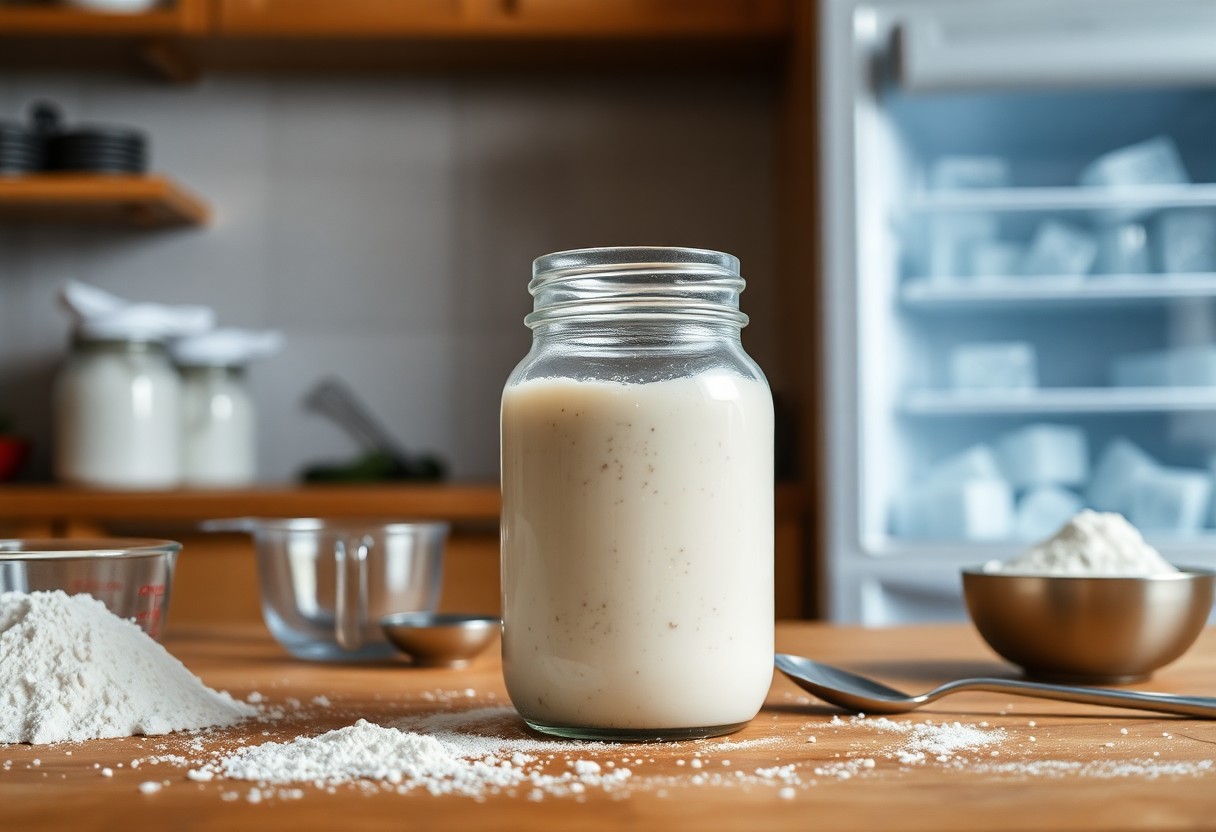Freeze your sourdough starter if you need to take a break from baking or are concerned about waste. This process can help preserve the viability of your starter for future use, ensuring you have it ready when you want to whip up a delicious loaf. In this post, you’ll learn about the best practices for freezing your starter, how to properly thaw and reactivate it, and important tips for maintaining its health during the freezing process. Let’s look into the details so you can make the most of your sourdough journey!

Understanding Sourdough Starter
As you examine into the world of baking, understanding sourdough starter is important. This living culture, a blend of flour and water, acts as your key ingredient to craft delicious sourdough bread. The starter not only provides leavening power but also contributes to the flavor and texture of the bread you’ll create. By nurturing your sourdough starter, you ensure a consistent and flavorful rise in your baking endeavors.
What is Sourdough Starter?
Starter is a mixture of flour and water that has been fermented over time, capturing wild yeast and beneficial bacteria from the environment. This dynamic culture is the foundation of sourdough bread, providing both leavening and distinctive flavor. As you feed your starter regularly with fresh flour and water, it becomes robust and ready to bake with, transforming your ingredients into a beautifully risen loaf.
The Role of Yeast and Bacteria
What makes sourdough starter uniquely versatile is the symbiotic relationship between yeast and bacteria. These microorganisms work together, where yeast primarily ferments sugars to produce carbon dioxide, causing the dough to rise, while lactic acid bacteria enhance flavor and acidity. This balanced ecosystem not only contributes to the bread’s texture but also its characteristic tanginess that sourdough lovers crave.
It’s fascinating how each batch of sourdough starter evolves, influenced by your local environment and personal feeding schedule. The wild yeast typically present in your kitchen is responsible for the rising action, while the lactic acid bacteria impart that signature sour flavor. This interplay not only enhances the taste of your bread but also adds to its health benefits, making your sourdough a wholesome addition to your diet.
Freezing Sourdough Starter
It is entirely possible to freeze your sourdough starter when you need to take a break from baking. Freezing preserves the yeast and bacteria, allowing you to extend the life of your starter for future use. When you’re ready to bake again, you can simply thaw it and reintroduce it back into your routine.
Why Freeze Sourdough Starter?
Against the notion that sourdough starters must be constantly fed and cared for, freezing your starter provides a practical solution for those times when you may not have the opportunity to maintain it. This way, your hard work in cultivating the starter is not wasted, allowing for flexibility in your baking schedule.
Best Practices for Freezing
At the time of freezing, ensure your starter is at its peak activity and has been fed recently. Divide it into smaller portions to make it easier to use later. Place the portions in airtight containers or freezer bags, and label them with the date for tracking. Always allow a little space in the container for expansion during freezing.
Freeze the starter at its most active phase, ideally about 6-12 hours after feeding. Doing this maximizes the yeast and bacteria’s viability. When you’re ready to revive your starter, thaw it in the refrigerator or at room temperature before feeding it again to reactivate the fermentation process. Be patient, as reawakening your starter may take a few feeds before it regains its full potency.
Thawing and Reviving Frozen Starter
Assuming you have successfully frozen your sourdough starter, it’s time to bring it back to life. The thawing process is vital, as it allows the dormant yeast and bacteria to awaken. You can start this revival journey by managing how you thaw your starter to ensure it wakes up healthy and strong.
How to Properly Thaw
After you remove your frozen starter from the freezer, place it in the refrigerator for 24 hours. This gradual thawing minimizes temperature shock and helps preserve the integrity of the yeast and bacteria, which are imperative for a robust sourdough culture.
Steps to Revive Your Starter
One you have thawed your starter, it’s time to feed it to revive its activity. Start by discarding a portion of the starter, leaving about 50 grams, and then feed it with equal parts of water and flour. Allow it to sit at room temperature to activate.
Understanding the steps to revive your starter can greatly influence its health post-thaw. After discarding a portion, add your chosen flour and water in a ratio of 1:1:1 (starter:flour:water). This feeding process should be repeated every 12 hours for the next couple of days to encourage fermentation. Soon enough, you’ll notice bubbles and a pleasant sour aroma, indicating that your starter is ready for baking again.

Common Issues and Troubleshooting
Your sourdough starter can occasionally present challenges during its fermentation journey. If you notice unusual smells, changes in color, or lack of bubbles, it’s important to investigate further. These issues may indicate that your starter is underfed, overfed, or even contaminated. Testing for these signs early on can help you restore the healthy balance needed for successful baking.
Signs of a Healthy Starter
Beside the characteristic bubbling, a healthy starter will have a pleasant, slightly tangy aroma. The surface should appear smooth and shiny, with a slight rise and fall pattern indicating consistent fermentation. You’ll also see regular activity within a few hours after feeding, showcasing its vitality and readiness for your baking adventures.
Addressing Potential Problems
Beside being vigilant about signs of a healthy starter, you should proactively address any potential problems that arise. If your starter isn’t bubbling like it should, it might need more frequent feedings or a warmer environment. In contrast, an overly sour smell can indicate it’s time to adjust your feeding schedule or change the flour type.
This proactive approach not only enhances the health of your sourdough starter but also ensures that your baking results are consistently satisfying. Regularly monitor its feeding schedule and environmental conditions. If you suspect any contamination, it’s best to discard the starter and start fresh to prevent it from affecting your baking. Keeping a close eye on these factors will help you maintain a strong and vigorous starter, ready for all your sourdough recipes.
Frequently Asked Questions
Not every sourdough starter is the same, and some types may handle freezing better than others. Specifically, starters that are more established and have been fed consistently often recover well after freezing. However, younger or less active starters may struggle to thrive after being frozen. To ensure the best outcome, assess the characteristics of your starter before deciding to freeze.
Can All Starters Be Frozen?
Around most sourdough enthusiasts, there are discussions about whether all starters can be frozen. The answer is that while many starters can be frozen successfully, some might not fare as well during the freezing process. Each starter has unique qualities that affect its resilience, so it’s vital to evaluate its health and activity level before freezing.
How Long Can You Store Frozen Starter?
Questions about how long you can store frozen starter often arise, and the general guideline is up to a year. Your frozen starter can remain viable for many months if you store it properly. Though it can last longer, the quality and leavening power may begin to diminish after about six months, so try to utilize it within this time frame for the best results.
Considering the longevity of your frozen starter, it’s important to keep it stored in an airtight container or freezer bag to prevent freezer burn and contamination. When you’re ready to revive your starter, thaw it in the refrigerator for several hours or overnight. Once thawed, resume regular feeding to restore its strength and vitality before using it in your sourdough baking. Following these steps helps ensure your starter remains active and ready for delicious baking adventures.
Tips for Maintaining a Healthy Starter
Keep your sourdough starter vibrant and active with a few simple practices:
- Feed it regularly with equal parts flour and water.
- Use filtered or non-chlorinated water to encourage healthy fermentation.
- Maintain it at a consistent, warm temperature.
- Store it in a breathable container to allow gases to escape.
The more attention you give your starter, the better the results will be.
Regular Feeding Schedule
Besides following a consistent feeding schedule, you should pay attention to the state of your starter. It’s best to feed it every 12 to 24 hours when it’s at room temperature, ensuring it has enough nutrients to thrive. You can adjust the frequency based on your starter’s activity and your baking needs.
Storage Options Beyond Freezing
Along with freezing your starter, you have other options for storage that can keep it healthy. You can refrigerate your starter for longer periods, allowing you to feed it less frequently, about once a week, while still maintaining its activity. If you choose to refrigerate, give it a good feed before storing, and allow it to come to room temperature and regain activity with a few feeding cycles when you’re ready to use it again.
This method allows you to balance convenience and care for your sourdough starter without compromising its health. A refrigerated starter can be easily revived and returns to its bubbly self with a little attention. Always check its consistency and aroma before using it in baking to ensure it’s still healthy and active.
Conclusion
Now that you understand the process, freezing your sourdough starter can be a practical way to preserve its life and keep it ready for future baking adventures. By following the proper steps to freeze and later revive your starter, you can maintain its strength and flavor over time. This allows you to easily take breaks from baking without the worry of losing your beloved starter. So go ahead, embrace the convenience of freezing and enjoy the versatility it offers for your sourdough journey.





Leave a Reply